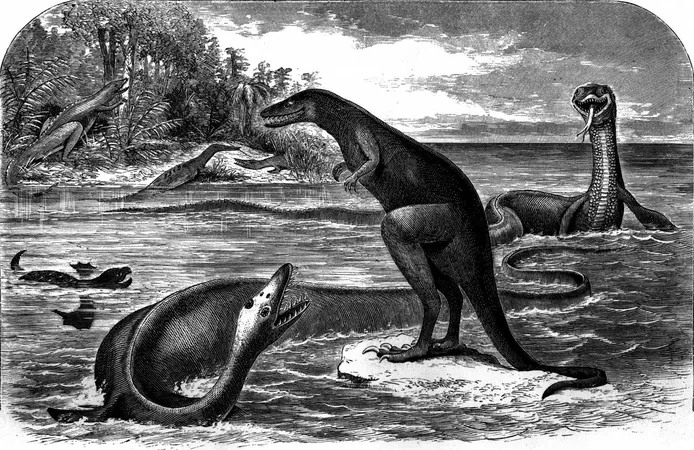
The Truth Behind 10 Mysterious Creatures from the Age of Dinosaurs - You Won't Believe What They Really Looked Like!
2024-12-30
Author: William
For centuries, paleontologists and artists have pieced together the appearances of dinosaurs and other ancient creatures, but their conclusions have often been hilariously inaccurate! Discover the surprising reality behind some of the most iconic dinosaur-age animals, and learn why our understanding of these majestic beasts continues to evolve. From a bizarre sea creature with its head in the wrong place to the real story behind flying reptiles, prepare to have your mind blown!
1. Iguanodon
Iguanodon was among the first dinosaurs ever discovered, with its fossils unearthed in 1822 by Mary Ann and Gideon Mantell. Initially thought to resemble a massive iguana, further discoveries revealed that Iguanodon was primarily a quadruped that could also walk on two legs when needed. Its famous thumb spikes were once mistakenly identified as horns – a blunder straight out of a dinosaur horror movie! Modern research has refined our image of Iguanodon, highlighting its versatility and unique characteristics.
2. Megalosaurus
The first dinosaur to be scientifically described in the early 19th century, Megalosaurus was originally depicted as a squat, lumbering beast. New fossil discoveries depicted this massive predator as a bipedal hunter that resembled a miniature Tyrannosaurus rex. Imagine roaming the land at 30 feet long and weighing 1.5 tons – this was no slowpoke!
3. Velociraptor
Forget what Hollywood has taught you! Velociraptors were not the size of the ferocious creatures seen in "Jurassic Park" but rather the size of a domesticated turkey. Equipped with feathers rather than scales, these feisty hunters utilized their claws to grasp rather than slash. The ongoing debate among scientists about their appearance continues to intrigue dinosaur enthusiasts everywhere.
4. Tyrannosaurus rex
One of the most well-known dinosaurs, T. rex, has continuously captured imaginations with its fierce reputation. Early interpretations of this iconic predator depicted it standing upright like a kangaroo, but the reality is that it strutted around with a horizontal posture, balancing its massive head and tail. Recent studies suggest that juvenile T. rex sported feathers—a science-fiction twist no one saw coming!
5. Pterosaurs
Initially mistaken for marine creatures or flying marsupials, pterosaurs turned out to be fascinating flying reptiles capable of soaring through ancient skies. They had diverse appearances and colors, with some sporting fuzzy filaments that sparked lively debates about their similarities with modern birds. Who knew they were the “fashionistas” of the Mesozoic era?
6. Spinosaurus
For decades, Spinosaurus remained shrouded in mystery. Once believed to be exclusively terrestrial, it’s now understood that this giant could swim – thanks to its unique body structure. With its impressive sail and semi-aquatic habits, Spinosaurus showcases how some dinosaurs adapted to different lifestyles in the ancient world.
7. Mosasaurus
What’s scarier than a dinosaur? A colossal marine reptile! Mosasaurus ruled the seas, but early interpretations depicted these sleek predators as awkward, snake-like swimmers. Yet, modern research has revealed their true glory: streamlined bodies and powerful tails similar to today’s sharks. Be wary of what lurks beneath the waves!
8. Scleromochlus
This enigmatic creature lived during the Triassic period and was initially misidentified as a small dinosaur. However, recent findings suggest it belongs to the flying reptile lineage, challenging old assumptions. Fitting more seamlessly into the evolutionary tree, Scleromochlus reminds us that appearances can be deceiving!
9. Elasmosaurus
Elasmosaurus was once the poster child for paleontological blunders! The famous fixed image of this long-necked marine reptile showed it with its head on the wrong end of its body, sending scientists into a fit of laughter and frustration. This mistake also fueled the infamous “Bone Wars”—a classic rivalry that showcased the competitive nature of early paleontological research.
10. Cetiosaurus
Last but not least, Cetiosaurus was initially thought to be a massive predator akin to a crocodile. With new findings, we've come to realize this huge sauropod more likely thrived on land rather than sloshing about in shallow waters. Imagine this colossal giant gracefully traversing the Jurassic landscape instead of flopping around in murky swamps!
While our understanding of these magnificent creatures has come a long way since the first dinosaur discoveries, the world of paleontology is still full of surprises and evolving theories. Each new fossil uncovered presents an opportunity to refine our knowledge and reopen the discussion on how these ancient beings truly lived and looked.
Stay tuned as more discoveries shed light on the breathtaking world of dinosaurs and their contemporaries!









 Brasil (PT)
Brasil (PT)
 Canada (EN)
Canada (EN)
 Chile (ES)
Chile (ES)
 Česko (CS)
Česko (CS)
 대한민국 (KO)
대한민국 (KO)
 España (ES)
España (ES)
 France (FR)
France (FR)
 Hong Kong (EN)
Hong Kong (EN)
 Italia (IT)
Italia (IT)
 日本 (JA)
日本 (JA)
 Magyarország (HU)
Magyarország (HU)
 Norge (NO)
Norge (NO)
 Polska (PL)
Polska (PL)
 Schweiz (DE)
Schweiz (DE)
 Singapore (EN)
Singapore (EN)
 Sverige (SV)
Sverige (SV)
 Suomi (FI)
Suomi (FI)
 Türkiye (TR)
Türkiye (TR)
 الإمارات العربية المتحدة (AR)
الإمارات العربية المتحدة (AR)